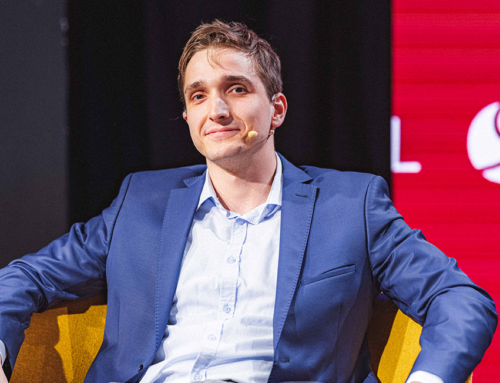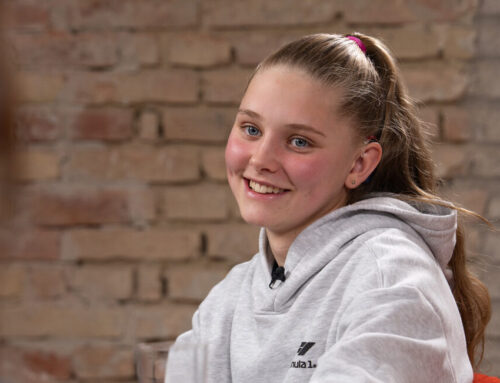Cochlear implants and cycling helmets are compatible!
It was important for Kurt Gregor to be able to wear a cycling helmet with his cochlear implant without any problems. He received his CI in April 2024 and won his next cycling race just two weeks after the activation.
Eva Kohl
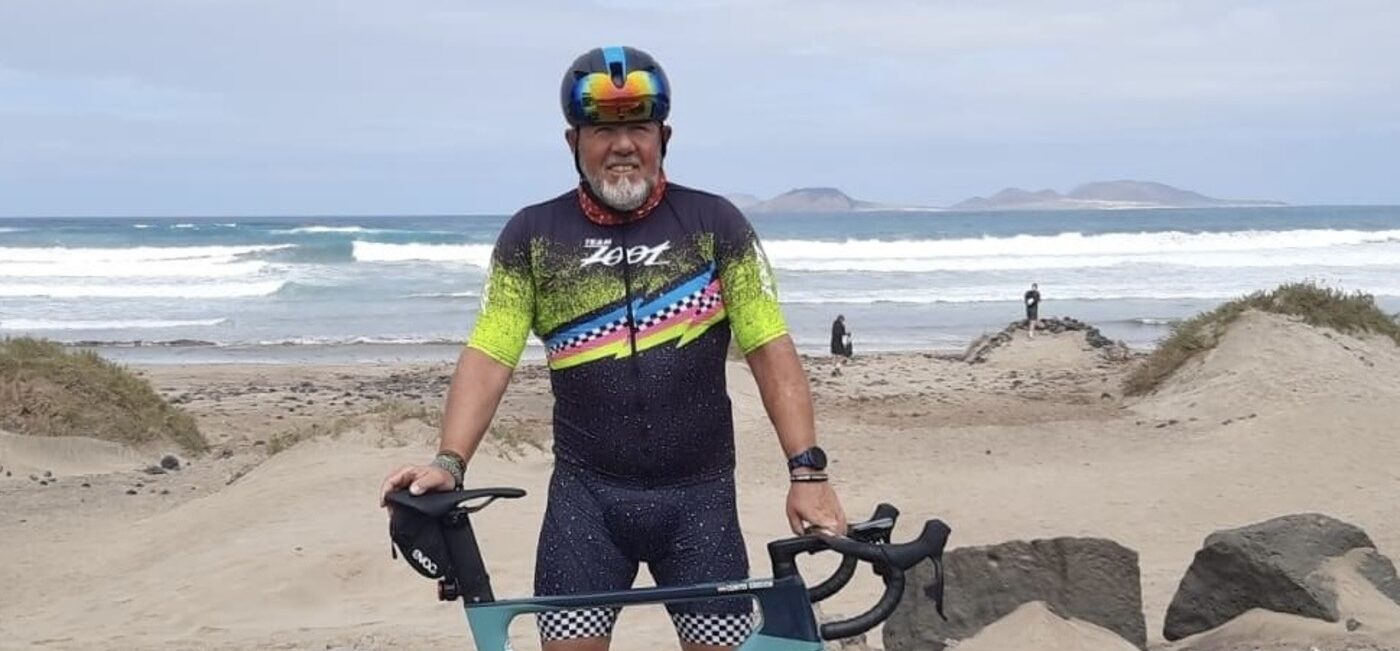
“Actually, I started doing extreme sports when I developed hearing problems,” smiles Kurt Gregor. He was in his early 40s at the time and had a full-time job. He and his wife were building their new house right next to a swimming pond. That's when he noticed his first hearing loss. His doctor requested a blood test, among other things - and, in view of the worrying values, urgently advised him to exercise. Not only the nearby swimming pond, but also previous successes as a swimmer in the ASV Vienna youth team suggested that he should start swimming more regularly again. During the cold season, the foreman of a large technology company switched to forest runs, and later to cycling.
One day, Gregor supported a friend as a coach at the Carinthian Ironman. This is a triathlon in which all three categories - swimming, cycling and running - not only cover particularly long distances, but are also held back-to-back. As a former competitive swimmer, the native Viennese could understand why the participants were prepared for the long swimming distance. “But to run and cycle that far: They're crazy, I thought.” Then he noticed: “There were some sturdier ladies there who were literally smiling after 42 kilometers of running!” That impressed him. Together with his wife, he gave it a try for the first time at the Vienna Marathon. Today he says: “Once you're hooked, you don't stop: When I turned 50, I took up triathlon.”
Endurance and extreme performance require long, consistent training. “I do it because it really energizes me,” assures the pensioner. “And because you can also learn a lot!”. That it's all in your head, for example; or that you should always expect the unexpected and have a plan B ready. Like during the bike race in London, when the Austrian had to patch his tire eight miles before the finish. A mile later, he had the second puncture. “The only thing that helped was a plan B,” he laughs: “I then rode seven miles to the finish with punctures.”
“I have to hear the referee on the Ironman bike stage!”
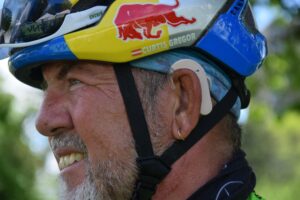
“There's no helmet that wouldn't fit now.” Kurt Gregor's bike helmets are all compatible with the SONNET 2 audio processor - from cheap to expensive helmets, and above all, without cutting anything out and jeopardizing safety. ©Kurt Gregor
“There! That was it, my first Ironman!” The amateur athlete points to a sign: Ironman Kärnten 2011. On the wall above, below and next to it, the start numbers of numerous other Ironman, marathon and half-marathon, triathlon and individual events decorate the wall of the driveway; in front of it, hanging on pulleys and bike racks, various training bikes for summer and winter as well as one of the bikes for competitions - with a carbon frame, power meter integrated into the pedals and cable-free Bluetooth gear shifting. Since he has hearing difficulties, his hearing aids are also a fixed part of his cycling equipment, because: “Hearing is perhaps a matter of taste for running, but it's essential for cycling.”
During long swimming distances, the water always lapping against his eardrums in waves affects his sense of balance: not a good scenario for competitions that continue on land immediately afterwards. That's why the extreme athlete wears swimming earmolds during swimming competitions - which means he sacrifices hearing. “I can also run without hearing. I can concentrate more on my body,” he assures us. He then talks about the little girl who stood on the sidelines and cheered her mom on - and how these cheers energized him, too.
He ran his last marathon in 2018, after which a vascular condition made further running competitions impossible for him. Cycling is all the more important to him now. It is important not only to hear the other cyclists - especially those outside his field of vision: Gregor also has to be able to hear the referee during the cycling stage of the Ironman. The referee accompanies the cyclists on a motorcycle, ensuring that distances and other competition rules are observed and giving appropriate instructions. “If you don't follow the referee's instructions, you get a time penalty,” explains the experienced competitor. But he can't imagine cycling without hearing: “It's because of the traffic!”
HEARO, the surgical robot: help with challenging anatomy

HEARO is the world's first robot designed for high-precision and minimally invasive cochlear implantation. ©Adrian Moser
Despite all his efforts, the 63-year-old's hearing has deteriorated over the last 20 years. As a result of his otosclerosis, the former supervisor of over 180 employees has been practically deaf for over 15 years. This process could be delayed thanks to an otoplasty operation on his right ear until a few months ago, when he could no longer understand enough on his right ear either, despite hearing aids and CROS treatment. Once again, he needed a plan B, this time for his hearing. His ENT doctor suggested a cochlear implant. At the ENT University Clinic in Vienna, specialist Priv.-Doz. Dr. Alice Auinger confirmed the indication. She suggested implantation on the left ear first, which had been deaf for some time.
However, the ossifications associated with otosclerosis are a challenge during implantation. Auinger explains: “If the cochlea is ossified, the ossification must be drilled out. Depending on the extent of the ossification, however, this can be difficult.” The HEARO surgical robot can help in this situation, as the surgeon explains. “HEARO independently and minimally invasively drills a tunnel through the bone behind the ear to the cochlea. Using the data from the computer tomography, the drilling can be planned and carried out precisely: The ossified areas in the cochlea are drilled out as much as possible. The electrode array can then be inserted further.” The deeper insertion enables a more natural sound with CI. It is also hoped that the nerve structures in the cochlea will be better preserved thanks to the precision of the drilling.
Complication-free cochlear implantation
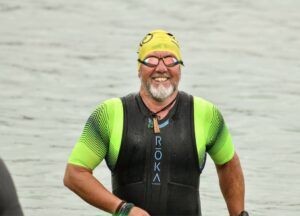
Kurt Gregor was already a successful swimmer as a teenager. ©Kurt Gregor
In April 2024, Prof. Dr. Clemens Honeder and Priv.-Doz. Dr. Alice Auinger performed the implantation. Three hours later, the patient was back in the room, and after another hour he went for a walk with his wife. “I was hungry, that's all,” says Kurt Gregor, still pleased afterwards about the complication-free operation. Three weeks later, the CI technician activated the associated audio processor: a soft beige SONNET 2 with a transmitting coil in a discreet tartan. Although he had not heard anything in his left ear for such a long time, the pensioner was able to report amazingly rapid hearing success: “I can already make phone calls with the CI after just two months! Others supposedly need a little longer.”
The enthusiastic sportsman is particularly pleased that all of his cycling helmets fit perfectly with the SONNET 2, from the “cheapie” helmet for training to the expensive one for racing: “There's not a single one that wouldn't fit now.” The transmitter coil - like the implant itself - is well protected under the helmet, the BTE part of the processor remains completely open in the exposed area above the ear and can pick up sound unhindered. Gregor also wears a bandana under his helmet, a tube scarf made of thin fabric - “to absorb sweat.” He got into the habit of doing this with his hearing aid.
Worldwide connection - for sport and hearing
It costs between 600 and 1,200 euros to take part in international competitions of this magnitude, excluding travel costs. Since his retirement, the Lower Austrian by choice has been able to take part in competitions that would not have been possible during his 45 years of employment. This year he even became the X-Waters world champion in his age group, finishing 8th across all age groups. That was in Malta. Other competitions have taken him to Italy or London - “a really beautiful area”, the USA or New Zealand.
Gregor quickly pulls some kind of amulet out of his collar. “From the Maori, I'm a tribal member there now,” he explains and slips the leather strap with the pendant back under his shirt. He got to know the indigenous people of New Zealand through a friend who was born Maori and has two cochlear implants. The former disability representative at his company is now networked with athletes with hearing impairments all over the world. The Facebook group is called Deaf Ironmen Events, where members of the deaf culture and users of different hearing systems exchange tips and support each other when taking part in sports competitions.
Gregor met numerous CI users there long before he decided to get a CI. Many of them would cut out the padding of their cycling helmets so that the processors would fit under the helmet, he explains. “But it's not smart to tamper with a helmet!” He refers to safety and insurance aspects with certainty: “If the referee at the competition sees that the helmet has been tampered with, he won't even let you start.” That's why it was so important to him that his bike helmet would fit with such a CI system even without manipulation and that the CI would work with a helmet.
The first competition medal with a cochlear implant

Kurt Gregor beim Gran Fondo New York, seinem ersten Bewerb mit Cochlea-Implantat. ©Kurt Gregor
“Let me show you something!”, the athlete proudly points to one of the numerous medals that adorn the staircase of the marital home; close together, strung on rods, sorted by competition. The successful extreme athlete has a special memory to tell about many of these. The most recent medal from the Gran Fondo New York in May 2024 will always be associated with the CI for him. The GFNY was the competition in which he was able to hear in his left ear again for the first time just two weeks after the CI was activated.
Hearing with a CI requires practice. But the pensioner can already hear around 20 percent better with the implant than before with the right ear with hearing aid and CROS fitting. “It's simply wonderful to enjoy music again,” he enthuses about his first concert with his CI: Rod Stewart in Vienna's Stadthalle. Then he sighs: “If I had known all this beforehand, I would have had it done sooner! Even if the CI wasn't necessary before, but because it's better!” Next winter, Kurt Gregor will get a CI on his right side as well. One to understand the referee at the bike race, regardless of which side he is shouting from; and two to hear well from both sides again in everyday life.

